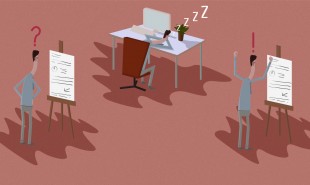
Wise passiveness: Harnessing the creativity on the edge of consciousness
“That we can feed this mind of ours
In a wise passiveness.” — William Wordsworth.
The act of finding the link between remote ideas — or free association — often features in the conversation around innovation and creativity. The ability to find a different perspective, a new angle, or to “connect the dots”, all stem from this fostering of unlikely connections, which usually occurs outside the grip of rational consciousness.
Of course, we do this everyday. In the bizarre sequence of a dream, our brain links experiences together in the form of imagery, ideas, emotions and sensations. Perhaps that is why many great writers, artists, and thinkers like to make use of this dream-state by working as soon as they wake up.
“Drowsy brains can conjure up new ideas from the debris of dreams and apply them to our creative pursuits,” says Scottish writer Karen Emslie. Thomas Jefferson, for one, would read books on moral philosophy before going to sleep, to ‘ruminate’ over it as he made his slow ascent back to consciousness; architect Frank Lloyd Wright would wake habitually around 4am, work for 3-4 hours, before taking another nap prior to commencing his day.
Of course, it’s difficult for those with an office schedule to experiment with their sleep/work pattern. However there are still ways we can harness the creativity untapped in this hazy state of mind in the modern office. Here are this fortnight’s Innovation Culture Five for you to try.
1. Making the most of your siesta. Many companies are beginning to implement office nap rooms. But instead of falling into a deep slumber after a particularly tasty sandwich, one could try Jefferson’s approach of mulling over the morning’s notes, tricky problems or an ideas board that has gone stale by resting one’s head at their desk, drifting off with these obstacles in mind. The Springwise-featured ostrich pillow could come in handy…
2. Keeping a notepad or recording device on your bedside table. You may be surprised by what you conjure up in the moments before you fall into sleep, or during the period between snoozing your first and fifth, sixth or seventh alarm.
3. Don’t dwell if answers aren’t materializing for a particular issue. Allow your mind to wander of its own accord via different areas beyond your industry, and even work altogether. You may not find the solution you’re looking for today, but come Sunday afternoon you might stumble across an enlightening idea that would open up a new avenue for your business.
4. Use your morning commute to empty your mind, instead of busying yourself with emails and notifications. “The idle mind is awake but unconstrained, free to slip untethered from idea to idea or meander from potential theory to potential truth.” Kinfolk magazine points to the fact that some of the most crucial scientific innovations and inventions were “happened upon after years of unproductive, leisurely puzzling.”
5. Dream collectively. Forward this email to your CEO or staff. Try to implement these tips in your workspace for a week or two, and see the impact it can have on your organization’s overall innovative thinking. Save creative thinking meetings for informal settings, where participants are in a freer, more relaxed mind frame. Leave the office, stroll in the sun, sit by a canal, or lie down on a patch of grass.
We try to practice what we preach. For the first time ever we’re sharing some dream-inducing music from the Springwise office via Spotify. If you have any thoughts, ideas — or insightful dreams — please feel free to get in touch.




